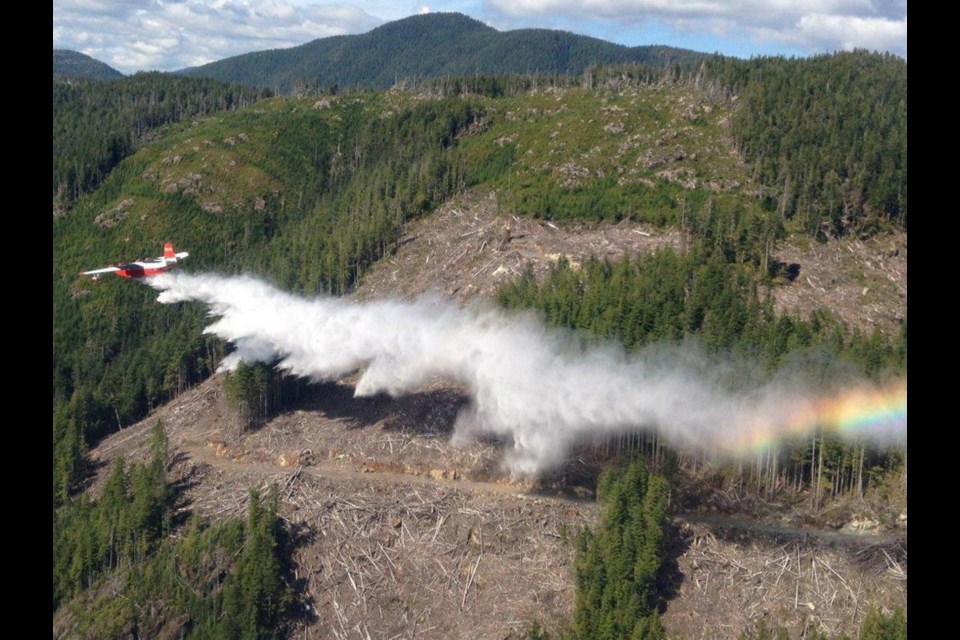The retirement of the last Martin Mars water bomber, the largest piston-powered propeller-driven aircraft in the world, marks the end of one chapter and the beginning of another for Wayne Coulson, head of Coulson Group of Companies in Port Alberni.
The Hawaii Mars has been pulled out of the water and is now parked on a ramp at Coulson’s Sproat Lake base, with the chances of it returning to firefighting service flickering like a dying ember.
But even as the Hawaii Mars slips into history, a brand-new plane bearing Coulson’s name is creating a buzz south of the border.
Since 2007, the province has given Coulson a direct-award contract for the Hawaii Mars.
But starting next year, the province will invite competitive bidding for a $1.8-million aerial firefighting contract. The Hawaii Mars, which can pick up 27,000 litres as it skims the water, will not be considered.
A direct-award contact for the water bomber — which has 53 years of history fighting B.C. wildfires — no longer makes economic sense, said Forests Minister Steve Thomson this week.
“The decision was based on the fact here are more cost-effective, efficient options available due to advances in airplane technology,” Thomson said.
Smaller aircraft with turbine engines and smaller drop patterns will be more suitable for B.C.’s mountainous terrain, he said.
The news isn’t going over well with Island residents, many of whom have an emotional attachment to the aircraft.
“I think the airplanes have been given a bum rap,” said Port Alberni’s Hugh Fraser, who piloted the Hawaii Mars and Philippine Mars from 1977 to 2010.
“There’s not an airplane in the world that can match what these can do under these conditions on Vancouver Island.”
He recalls a fire on Denman Island near Turbine Bay that overran the resources on the ground and threatened some expensive homes. The two water bombers extinguished the blaze with two drops each, the operation completed in less than an hour.
Coulson understands that people are upset.
“I’ve had lots of phone calls, had lots of retired loggers come visit me who remember working underneath the aircraft, saying how it saved this valley and that valley,” Coulson said this week.
“The Mars has been around a long time; it has stood the test of time as far as effectiveness goes.”
Coulson questions the government’s argument on economics, saying he charged the province $672,000 a year to have the Hawaii Mars on standby. There was an additional charge for call-outs.
“They’re going to replace [the Mars] with newer equipment with less capacity, for $1.8 million a year,” Coulson said.
Ten jobs will be lost with the retirement of the Mars, said Coulson, and in a town like Port Alberni, that has a big impact.
“Those airplanes have been the face of the community for a long time,” he said.
The Hawaii Mars has also been a Canadian ambassador, fighting fires in California and Mexico. Coulson remembers seeing 1,000 people line the shore when the Mars landed on a California lake.
The water bomber gave people hope that their homes would be saved from raging wild fires, Coulson said.
“The Mars became a tool that people depended on — they felt comfort,” he said.
He’s a little offended that the Hawaii Mars would be dismissed because it’s old, being the product of the Second World War.
“It’s like saying everyone should retire at 65 because they don’t create value anymore,” he said.
“That’s the heartstrings the government tugs on when it says the Martin Mars is too old. If it was unsafe to fly in the province of B.C., Transport Canada would be all over us. That hasn’t happened.”
Coulson said he didn’t make any money off the Mars, and kept the aircraft in operation because it was the right thing to do. It kept a dedicated team in their jobs and kept an Island icon in the air.
“It wasn’t a great business,” Coulson said. “It taught me a lot about firefighting. It created a lot of new opportunities.”
As the Hawaii Mars awaits its next move — to either a private owner or a museum — Coulson is looking ahead with anticipation to a new acquisition: a C-130Q Hercules contracted by the U.S. Forest Service and on the cutting edge of water bomber development.
“It’s a wonderful aircraft, too,” said Coulson of the turbine-powered aircraft.
CNN recently toured the aircraft at its California base. The remodelled aircraft and former member of the presidential fleet is fast becoming a “media queen,” Coulson said.
“It’s very exciting.”



